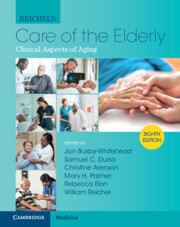Book contents
- Reichel’s Care of the Elderly
- Reichel’s Care of the Elderly
- Copyright page
- In Memoriam
- Contents
- Contributors
- Section I General Approach to the Care of the Elderly
- Section II Geriatric Syndromes
- Chapter 8 Frailty
- Chapter 9 Fall Prevention in Community-Dwelling Older Adults
- Chapter 10 Evaluation and Management of Dizziness
- Chapter 11 Evaluation and Management of Dementia
- Chapter 12 Recognition, Management, and Prevention of Delirium
- Section III Care of the Elderly by Organ System
- Section IV Principles of Care for the Elderly
- Index
- Plate Section (PDF Only)
- References
Chapter 11 - Evaluation and Management of Dementia
from Section II - Geriatric Syndromes
Published online by Cambridge University Press: 30 June 2022
- Reichel’s Care of the Elderly
- Reichel’s Care of the Elderly
- Copyright page
- In Memoriam
- Contents
- Contributors
- Section I General Approach to the Care of the Elderly
- Section II Geriatric Syndromes
- Chapter 8 Frailty
- Chapter 9 Fall Prevention in Community-Dwelling Older Adults
- Chapter 10 Evaluation and Management of Dizziness
- Chapter 11 Evaluation and Management of Dementia
- Chapter 12 Recognition, Management, and Prevention of Delirium
- Section III Care of the Elderly by Organ System
- Section IV Principles of Care for the Elderly
- Index
- Plate Section (PDF Only)
- References
Summary
Dementia is a clinical syndrome characterized by global cognitive decline, involving deficits in memory and at least one other area of cognition, and affects over 47 million persons worldwide. While Alzheimer’s dementia is the most common cause, it commonly co-occurs with other dementia-related pathologies such as cerebrovascular disease and Lewy body disease. The evaluation and differential diagnosis of dementia involves history taking with outside informants, thorough medication review, examination focused on phenomenology and associated features, and a workup for potential causes. Depression and delirium due to other medical causes may overlap with symptoms of dementia, and should be considered in a dementia evaluation. The four pillars of dementia care are: (1) disease-oriented treatment, (2) symptomatic treatments, (3) supportive care for the patient, and (4) supportive care for the caregiver. Management usually involves psychological, social, and environmental adjustments. Disease-modifying pharmacotherapy for dementia is still under development, and has largely been unsuccessful. Although symptomatic treatments such as cholinesterase inhibitors and memantine are available, they provide a modest and temporary stabilization of cognitive changes associated with the disease, and do not reverse or stop the degenerative process.
Keywords
- Type
- Chapter
- Information
- Reichel's Care of the ElderlyClinical Aspects of Aging, pp. 112 - 128Publisher: Cambridge University PressPrint publication year: 2022

